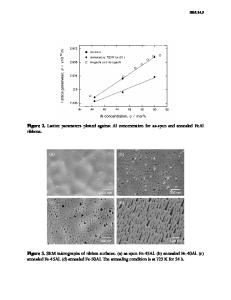Annealing Studies of B2 FeAl
- PDF / 399,759 Bytes
- 6 Pages / 420.48 x 639 pts Page_size
- 59 Downloads / 319 Views
ANNEALING STUDIES OF B2 FeAI
Berndt Schmidt, Pavan Nagpal and Ian Baker Thayer School of Engineering, Dartmouth College, Hanover NH 03755
ABSTRACT' Rods of five FeA1 alloys whose compositions span the B2 phase field (34-51 at. % Al) were produced by multiple hot extrusions of ingots. Samples of each alloy were annealed in air at 1173K and 1473K in order to study the effect of alloy composition on both the grain growth kinetics and on the rate of oxidation. Little oxidation occurred at 1173K but at 1473K the oxidation rate was found to decrease with increasing aluminum concentration. The predominant oxide was found to be a-A1203. The grain size was found to increase rapidly during the first hour of annealing at both temperatures after which it increased more slowly. The grain growth rate was found to decrease with increasing aluminum content. Hardness measurements were made on both as-extruded and annealed samples of FeAl. Hardness increased with increasing aluminum content. The hardness was higher in annealed and air-cooled samples due to vacancy retention. Compression tests of air-cooled, annealed samples also showed higher yield strengths than as-extruded samples. Yield strength and strain hardening rate were found to increase and the ductility was found to decrease with increasing aluminum content.
INTRODUCTION There have been no systematic studies of either oxidation kinetics or grain growth kinetics in B2- structured (ordered b.c.c.) FeAl. The only published report of oxidation of FeAI was by Nakayama [1] who noted that both Fe 203 and A120 3 formed on Fe-45A1 (in at. %) after five minutes anneal at 973K, but after three minutes anneal at 1273K the oxide was largely a-A120 3 : a-A120 3 is also the prevalent oxide that forms on NiAl after annealing at high temperature [2]. Nakayama [1] also found that the rate of oxidation of dilute Fe-Al alloys decreases as the aluminum content increases. The effect of annealing on grain growth in FeAl was first reported by Whittenberger [3] who found that the grain size of Fe-40AI, produced by hot compaction of powders, increased from 55gtm to 185gtm after 16hrs at 1535K. Similarly, Baker and Gaydosh[4] noted an increase in grain size from 161im to 27jim in Fe-47AI, produced by hot extrusion of melt-spun ribbons, after 5 hours at 1473K. It is important to note that in these two studies the FeAl contained many oxide particles, which probably retarded grain growth. Gaydosh and Crimp [5] have examined grain growth in melt-spun ribbons: little grain growth was observed after annealing at 1048K whereas annealing at 1583K produced an increase in grain size from 61im to 20jtm in Fe-40AI, from 8gm to 13jtm in Fe-45AI and from 9jim to 40gtm in Fe-50A1 (the study was complicated because the increase in grain size was limited by the ribbon thickness of 25-38jtm). The mechanical properties of FeAI have been systematically examined as a function of both aluminum content and temperature. Studies by Westbrook [6] showed that microhardness decreased with decreasing aluminum content and in
Data Loading...











